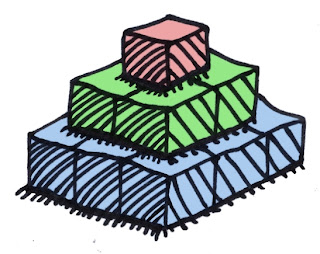 More than anything, creativity comes from our artwork. It is our mark-making capabilities that make us inimitably human (though, isn't it cool that some elephants can paint?).
More than anything, creativity comes from our artwork. It is our mark-making capabilities that make us inimitably human (though, isn't it cool that some elephants can paint?).Of late, I have taken up drawing again, partly for use in this blog, and I have been exploring some old and some new avenues of illustration. Painter, since I wrote it, has been one of my main conduits of expression when drawing. Before that, I used pencil and paper, felt pen, ball-point pen, and whatever I had at hand. I even used scratchboard (a medium acquired when building Painter, at the suggestion of John Derry).
Nowadays I use an Ultra-Fine Sharpie. Usually black, on very thick paper (28#) so it won't leak through. This was the medium I used for the blocks image at the top of this blog. And also for the pyramid image.
 Here I draw some blocks on top of each other. I made this image as an anti-minecraft homage, since the blocks do not really line up with each other from level to level. Here you see the original Sharpie drawing, scanned directly.
Here I draw some blocks on top of each other. I made this image as an anti-minecraft homage, since the blocks do not really line up with each other from level to level. Here you see the original Sharpie drawing, scanned directly.My usual method for illustration in this blog is to scan the image and read it into Painter. At that point, I clean up all the mistakes and funny ends, and lines that should meet but don't, and also the lines that overshoot. But I usually don't move the lines much. This retains the sketchiness of the original.
 I also like to color the illustrations, using a gel layer in Painter.
I also like to color the illustrations, using a gel layer in Painter.You can see the effect of this kind of editing here, on a new version of this pyramid image. You can see exactly what I was drawing, for one thing. But it still retains the informal sketchy look that my illustrations need.
I employ hand-drawn and edited illustrations and I am quite sure that none of these will infringe on copyrights. After all, I drew them. I also retain all the original drawings for future reference. If necessary, I could scan them again at higher resolution and use that result for a new illustration. If I wanted a new color scheme, or some substantial edit, for instance.
My work with fabric has led me to do quite a bit of hand-drawn art lately. I even continued this with a considerably-more-challenging follow-up post. In this, I have sought to create a more realistic sketch look. For fabric, I start with a picture, clone it, and then add sketchy shading and highlights. It is an involved process, but it has been tuning up my sketching chops.
 When doing work directly in Painter, using a Wacom tablet and pressure-sensitive stylus, sketchwork becomes very interesting because you can capture the essence of human expression, and yet it remains editable and adjustable.
When doing work directly in Painter, using a Wacom tablet and pressure-sensitive stylus, sketchwork becomes very interesting because you can capture the essence of human expression, and yet it remains editable and adjustable.Here I show some work I did this evening using Painter and nothing else. I took a picture of my hand with an iPhone (it was quite blurry) and cloned it, but really I didn't use the clone colors. Instead, I cleared out the clone and used the tracing paper for reference to sketch the outlines. Then I looked at the original to get a better feeling for the shading and put it all in by hand.
So this is a hand-drawn hand, having drawn the pyramid.
When drawing something, it is important to think creatively, and have an intuitive feeling of what you want the drawing to look like.
No comments:
Post a Comment